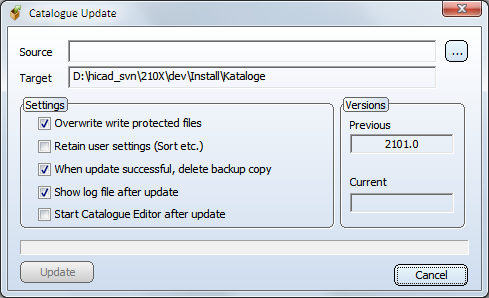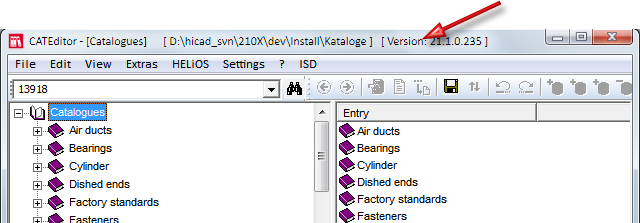
You use the program CatalogueUpdate.exe in the HiCAD EXE directory to update catalogues. This program is normally started automatically, e.g. when HiCAD is updated. It can also be started manually, if catalogues are to be exchanged between customers.

|
Source |
Path of the new/changed catalogues. For automatic updates the source is preset. |
|
Target |
Path of the catalogues to be replaced. The field is filled in automatically. Manual entries in this field are not possible. |
|
Settings |
Here you specify the settings for the update by activating or deactivating the checkboxes. Please note that the activation of the Retain user settings option is possible, but generally not recommended. If you have activated this setting, some tables may not be displayed correctly. If required, check the log file. |
|
Versions |
Previous In this field the version of the catalogue directory is displayed. Current The current HiCAD version is detected via the Registry and is displayed in this field. Manual entries in this field are not possible. |
 Important:
Important:
The version of the utilized catalogue directory will be checked upon HiCAD start. If the catalogue directories are old there is a risk that HiCAD will search for catalogue entries which do not yet exist in the old catalogues. One example of this are the Textures that were integrated in the catalogue some time ago. If these are missing in the catalogue, you will have no access to these textures in HiCAD.
If you start HiCAD with an old catalogue directory (e.g. HiCAD 2100.1 with Catalogue 2100.0 or HiCAD 2100.0 with Catalogue 2002.2), a corresponding message will be displayed:

If the version of the catalogue cannot be detected, the following message will be displayed:

 Please note:
Please note:


Standard Parts and HELiOS (PDM) • The 'HELiOS' Menu • Link Columns to Part Attributes
|
© Copyright 1994-2018, ISD Software und Systeme GmbH |